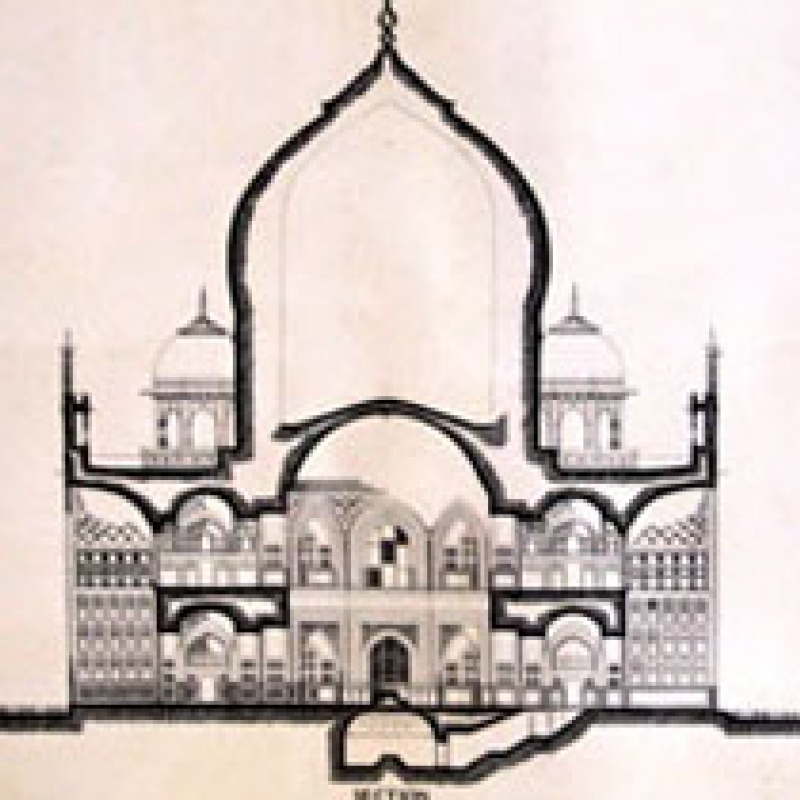Fig. 1: Taj Mahal (photo Rachita Jain)
Annually, thousands of Indian and international tourists come to visit this white marble tomb placed in a spectacular garden complex. The Taj is attractive to tourists for various reasons: it is one of the greatest monuments in the world, one of its Seven Wonders, is associated with eternal love and is one of India’s greatest assets. Few, having experienced the tomb and its garden, leave unimpressed, for the dazzling white of the mausoleum’s marble whose color changes subtly as the earth turns, the absolute symmetry of the architectural design, as well as the sheer scale of the massive complex leave most in awe. On a more factual note, this impressive site was built by the Mughal emperor Shah Jahan (r. 1628–58) after the death of his favorite wife, Mumtaz Mahal, in 1631. Most of the complex was built between 1632 and 1647/8. Although repairs, restorations and even changes, especially in the plantation of the garden, have transpired over the last 350 years, the overall complex remains consistent with Shah Jahan’s original vision.
The Mughals and Shah Jahan
The first Mughal, Babur, traced his lineage from both the Mongol Genghis Khan (d. 1227) and the great Central Asian warlord, Timur (d. 1405), whose 15th century successors produced art and architecture that became the gold standard of artistic creation in the Persian speaking world. Babur defeated the last independent Muslim ruler of north India in 1526. He only ruled for four years but introduced into the subcontinent, the Timurid tradition of ordered and regular gardens, in which the land was divided by water channels and pools. While such gardens, known as charbagh or four part gardens, are usually considered paradises on earth, for Babur and his successors, these gardens had a political meaning, that is, they were considered as visual metaphors for the Mughals’ ability to order and rule a land and people that Babur considered to be chaotic and unruly.
Babur’s son and successor, Humayun, did little to enhance Mughal authority, and for a 15 year period was forced to flee India, able to return in 1555 and reclaim the Mughal throne. Humayun died a year later and was succeeded by his son, Akbar, who ruled for nearly 50 years (1556-1605). Under Akbar’s long reign, the empire was enlarged and consolidated to cover most of the northern subcontinent reaching to the Deccan. Rather than punish Rajput princes and others whose territory Akbar enfolded into the Mughal empire, Akbar included these defeated elite into his own administrative and military system. He ensured loyalty from these newcomers by often marrying their daughters. Further stabilizing the new empire, currency and modes of taxation were standardized. Policies promoting tolerance among India’s various religious communities were adopted. As Akbar’s empire grew, he added forts and palaces across the land as a visual reminder of his ever increasing authority and power. Among his first architectural projects was the tomb he provided for his father, Humayun, which served as an important model for the future Taj Mahal (Fig. 2).
Fig. 2: Humayun's Tomb, Delhi, west façade (photo Mehreen Chida-Razvi)
Upon Akbar’s death in 1605, his son Jahangir ascended the throne, ruling until his death in 1627. The empire he inherited was strong, stable and wealthy, and Jahangir made few significant changes to policies and practices established by Akbar. Jahangir continued to build, although he is better known for his passion for painted albums and manuscripts as well as for his careful observations of nature. Military campaigns were not undertaken by the emperor but rather by his highly competent son, Khurram, the future Shah Jahan. Prince Khurram was the favored heir, until the early 1620s when Jahangir’s powerful wife, Nur Jahan, began to promote another of Jahangir’s sons to be next in line for the throne. Khurram rebelled and established a counter-court; but within a year after Jahangir’s death, this prince proclaimed himself emperor, assuming a title that his father had given him after a successful military campaign, Shah Jahan, ‘King of the World’.
Shah Jahan ruled for 30 years, continuously promoting himself as a semi-divine ruler who was fully cognizant of the value of the visual to achieve these ends (Fig. 3).
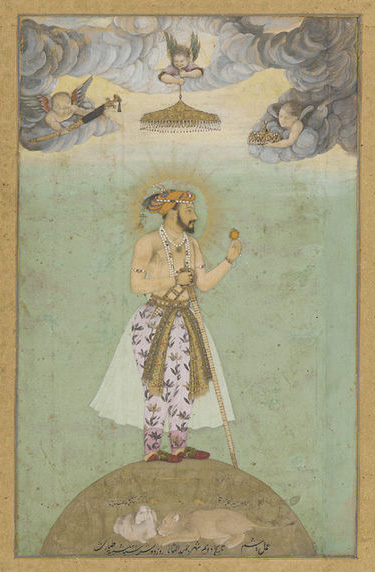
Fig. 3: Shah Jahan on a globe
Both his portraiture, which often depicted him literally as King of the World as he stands on a globe, and his highly symbolic architecture were intended to showcase him as belonging to a lineage of great rulers. Shah Jahan likened himself to the just king Solomon, something his Ottoman predecessor had done some 100 years earlier. The impression is of an aloof, perhaps even arrogant ruler, but historical sources indicate a more human side of this Mughal emperor.
Prince Khurram married Arjumand Banu Begum, later to bear the title of Mumtaz Mahal, in 1612 after a five year engagement, and she became his constant companion, even accompanying him on all his military campaigns until her death in 1631. Women had long had a major role in the outcome of Mughal politics. For example, Akbar often sought the council of his mother, but as we have in this case of Akbar’s mother, it was more often the council of senior female elites that could make or break relationships. Jahangir’s powerful wife, Nur Jahan, was a notable exception, for she was in many ways the de facto ruler, not a behind-the-scene Queen Mother, as her aging husband’s health deteriorated. Similarly, Mumtaz Mahal, a niece of Nur Jahan, had great influence over her husband, although we do not know specific examples. Chronicles reveal that although Shah Jahan had two other wives, Mumtaz Mahal remained his soulmate throughout their 19 year marriage. During this time Mumtaz Mahal gave birth to 14 children, half of whom survived. But shortly after delivering her last child, she became extremely weak, called for her husband and died. The devastated emperor went into mourning, not interacting with his court for a good week and then, for the next two years, continuously grieved. In the meantime the queen was buried temporarily in a garden in Burhanpur, the city in the Deccan where she had died; six months later her body was interred and moved to Agra at a site chosen for her mausoleum, the Taj Mahal, which was the result of an exchange of land from a high-ranking noble. Shah Jahan long outlived his wife, dying in 1666. The last eight years of his life, however, were not spent as an active emperor, but rather by 1658 he had been deposed by one of his sons, Aurangzeb. He was imprisoned in his Agra fort, overlooking the Taj Mahal, whereupon his death he was interred next to Mumtaz Mahal.
The Tradition of Mughal Funereal Architecture
Following the Timurid tradition the Mughals were great patrons of the arts including painting, architecture and luxury arts such as jade carving, textile production, jewelry, metal objects, military paraphernalia and more. The other contemporary Muslim dynasties of this time, the Ottomans of Turkey and the Safavids of Iran also engaged in similar production and consumption to prove their elite status. But the Mughals, more than any other Islamic house, engaged in the construction of tombs, particularly during the late 16th, through 17th centuries, a timeframe that is roughly concurrent with the construction of the Taj Mahal. Tomb construction had been practiced in the subcontinent at least as early as the 10th century in what is today Pakistan, where Muslims had assumed political authority in the eighth century. Once Muslim rulers established themselves in central north India by the beginning of the 13th century, mausolea were built for rulers and their elite. Since the Mughals controlled a vast amount of territory, increasing numbers of elite were required for the military and administration, but all the same why are there so many extant Mughal tombs? Ebba Koch has suggested that tomb construction may essentially be a form of estate planning. That is, tombs in Mughal India, always set in gardens, were exempt from the customary requirement that land must revert to the state upon the landholder’s death. While many tombs intended for the elite survive, it is the imperial Mughal mausolea that attract the most attention.
The first major Mughal imperial tomb complex was the one provided by Akbar for his father, Humayun, in Delhi close to the shrine of an important Muslim saint, Nizamuddin Auliya, and the then Mughal fort today known as the Purana Qila (Fig. 2). Humayun’s tomb was completed in 1571 and designed by a father-son team from Bukhara trained in both structural and landscape architecture. This large domed structure is a Baghdadi octagon, that is, an octagon with four alternating long and short sides. It sits on a high plinth in the middle of a charbagh garden. In overall scale, design and garden plan, the structure belongs to the Timurid tradition. The interior too, consisting of a central chamber surrounded by eight smaller rooms in a plan known as hasht bihisht or eight paradise is also Timurid in inspiration. The use of red sandstone as the structure’s veneer, detailed with white marble trim is part of a long standing tradition in north Indian architecture, particularly in buildings associated with Muslim patrons. Placing the tomb in a garden setting is probably a Mughal innovation. The garden can be read on two levels, one as an earthly paradise and the other as a symbol of political control as introduced by Babur. Following Timurid tradition, Humayun’s tomb was probably designed as a Mughal dynastic tomb; although no other emperor was buried there, a number of royal elite later were interred in Humayun’s tomb.
When Akbar died in 1605, Jahangir commenced his tomb complex on the outskirts of Agra, today known as Sikandra, but then called Bihishtabad, meaning the ‘Abode of Paradise’ (Fig. 4).
Fig. 4: Akbar's tomb at Sikandara (photo Rachita Jain)
Like Humayun’s tomb and later the Taj Mahal, Akbar’s tomb is also set in a walled garden complex with waterways that divide the complex into four main units. The tomb, though, as well as the tomb later built for Jahangir in Lahore, has no dome, but its upper terrace is left open, to conform to a passage in the tomb’s inscription: ‘May [Akbar’s] soul shine like the rays of the sun and the moon in the light of God’. An element in common with the Taj Mahal is the accessible underground crypt where the royal deceased are interred, for in the Muslim tradition the dead are to be buried six feet beneath the ground. The cenotaphs marking other floors would mirror the actual ones below ground. All imperial Mughal tombs have elaborate entrance gates, and Akbar’s tomb is no exception. Two features of its gate reappear at the Taj Mahal. One feature is the four white marble minarets that mark the corners of the entrance; at both Jahangir’s tomb and the Taj Mahal, similar minarets will be placed not on the entrance, but at each corner of the plinth. A second feature is the long inscription which embellishes both sides of the gate. This is a Persian poem especially written for this monument and designed by the calligrapher ‘Abd al-Haqq Shirizi, who was honored with the title Amanat Khan. The poem praises the deceased emperor, Akbar, and the patron, Jahangir, but ends with verses inviting the visitor to enter the gardens of paradise. While imperial Mughal gardens, especially those associated with tombs, are generally associated with visions of paradise, this poem on the complex’s entrance gate makes this reference clear.
Paradise, in Islam, is the reward for the true believer on the Day of Judgment. Sufis, mystically inclined holy men, were believed to be among those to surely find a place in paradise. The tombs of important Sufi saints, most notably the tombs of the Chishti saints, Moinuddin in Ajmer and Nizamuddin Auliya in Delhi, were made of white marble and had associations with sanctity and purity. Over time structures predominately made of white marble were made for the use of the emperor and his immediate family, but not for others. Jahangir’s queen Nur Jahan constructed a white marble tomb that was richly inlaid with multi-colored stones for her mother who died in 1621 and her father who died shortly afterward. Nur Jahan’s father was Shah Jahan’s finance minister and very close to Jahangir, but not of royal blood. Thus the tomb’s appearance as pure white marble from a distance that changes to one of multiple colors as one comes nearer is probably a reflection of the mother’s and father’s elite but not royal status. Although the tomb was built for husband and wife, it is known as the tomb of Itimad-ud-Daula, after the father’s official title. The tomb, completed in 1626-8, like other imperial Mughal mausolea, sits in the center of a walled charbagh and its ground floor adheres to the hasht bihisht plan. The second story, consisting of a central chamber enclosed with exquisitely carved screens, is capped by a truncated pyramidal vault. Each corner of the plinth is marked by a short minaret. While the complex is smaller than any tomb intended for an emperor, its inlaid décor gives the structure an unprecedented elegance. Not surprisingly, floral and geometric designs are found, but more innovative are the images of cypress trees, fruit and slender necked vessels for nectar inlaid into the white marble surface. This imagery, drawn from classical Persian poetry and the Quran, is intended to place the complex in a paradisiacal setting.
The Taj Mahal
The white marble domed structure that best represents the Mughal fascination with the imagery of paradise in a funereal setting is the Taj Mahal. While today the Taj Mahal and its garden complex appear to sit alone along Agra’s Yamuna riverfront, in fact it was one of many—admittedly the largest—of garden complexes built by Mughal elite that lined the river’s banks. The Taj complex though was the only one that spanned both sides of the river. On the south side was the mausoleum and its garden, while across from it was the Mahtab/Mehtab Bagh, Moonlight Garden, with its reflecting pool.
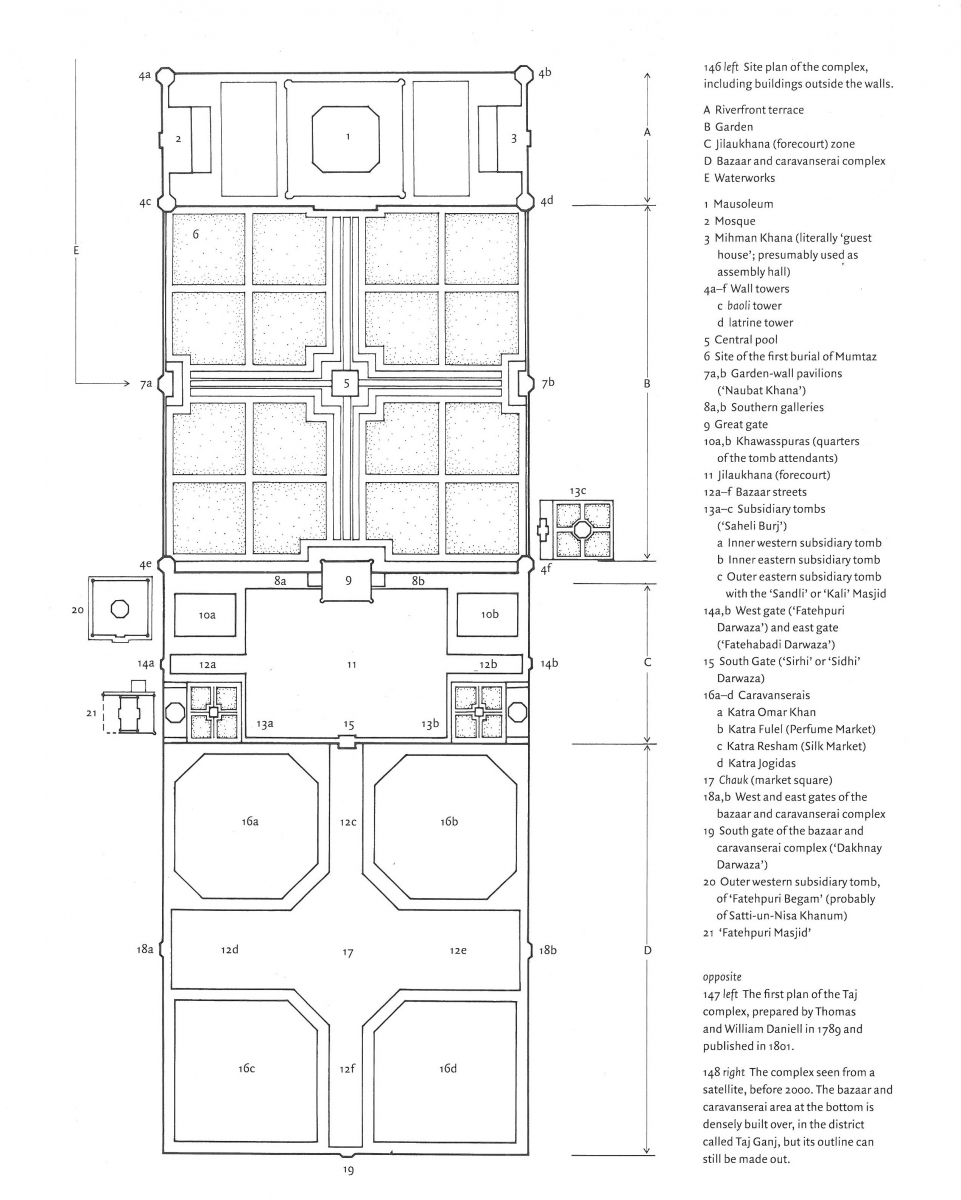
Fig. 5: Site plan of the Taj complex by Ebba Koch
Most visitors to the Taj Mahal think of the marble tomb and its garden as the complex, but there is much more, for this massive complex was almost a city within the city of Agra, then the Mughal capital and known officially as Akbarabad (Figs. 5, 6 and 7 from Ebba Koch).
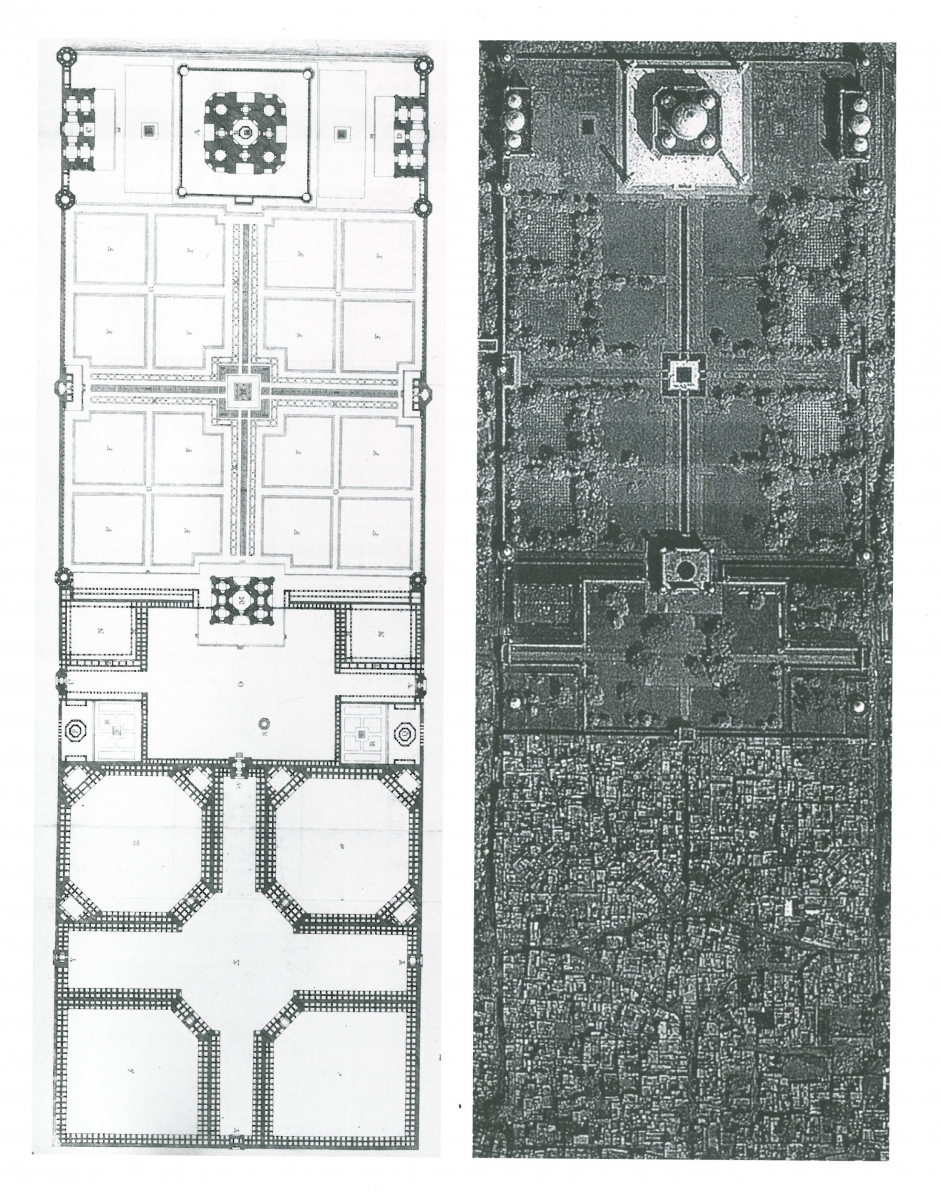
Fig. 6: The first plan of the Taj by Thomas and William Daniell (courtesy Ebba Koch)
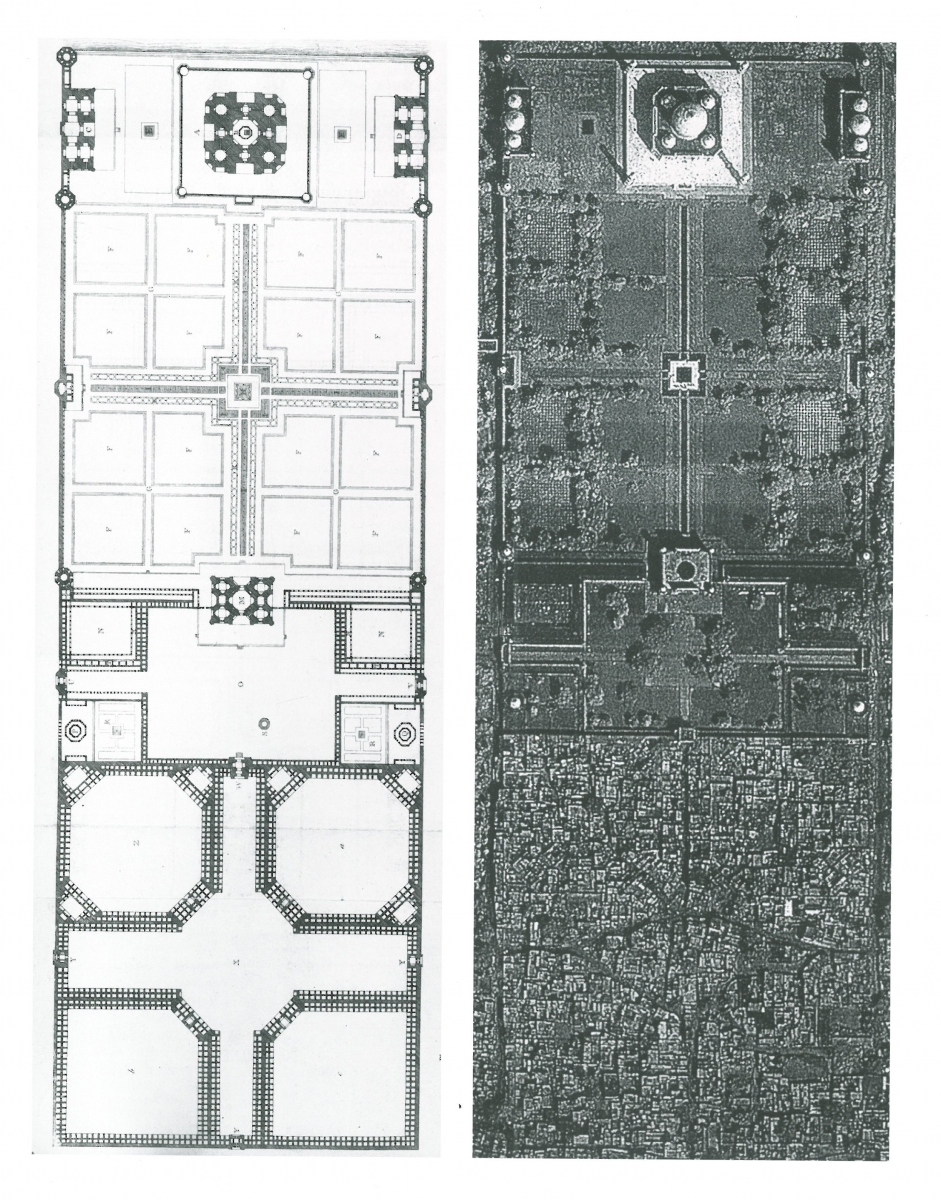
Fig. 7: The first plan of the Taj complex by Thomas and William Daniell (courtesy Ebba Koch)
We can roughly divide the complex into four areas: an area for four main markets known today as Taj Ganj, the forecourt into the tomb’s main garden; the tomb and other buildings in the main garden, and the Mahtab Bagh across the river. Taj Ganj held at each of its four corners, large enclosed markets with multiple shops whose goods were praised by Persian panegyrists and near contemporary European travelers. While the gates of Taj Ganj still survive, much of the original construction has been replaced or remodeled to serve the needs of backpackers and locals. The forecourt is a spacious area before the entrance into the tomb‘s garden with a double row of shops radiating from the east and west entrances, the income of which helped maintain the complex. Two corners of the forecourt hold small uninscribed tombs, while the other two corners served as residential quarters for the complex’s attendants.
The dominant feature of the forecourt is the stunning entrance gate located in the center of the north wall that leads to the main garden complex (Figs. 8a and 8b).
Fig. 8a: The Darwaza-i-Rauza ('great gate', photo Rachita Jain)
Fig. 8b: The Darwaza-i-Rauza (photo Rachita Jain)
Fig. 9: Entrance to Akbar's tomb at Sikandara
This large arched gate, faced with red sandstone, recalls the entrance to Akbar’s tomb (Fig. 9), but chattris (small domed kiosks) mark each corner not the minarets found on Akbar’s tomb. The entrance gates to both Akbar’s tomb and the Taj Mahal bear inscriptions designed by the same calligrapher, Amanat Khan. While those on Akbar’s tomb were in Persian, the inscriptions on the Taj Mahal’s entrance gate are drawn from the Quran and are thus in Arabic. The theme of each is similar, for they invite the believer to enter paradise.
Passing through the entrance gate the white marble mausoleum set at the end of this first garden dominates the skyline. Between the entrance and the tomb is the long rectangular garden divided into four quadrants by wide waterways that meet at a central pool that contemporary texts equate with al-Kausar, a Quranic chapter which likens God’s generosity to a pool of abundance. Known in contemporary texts as the ‘paradise like garden’, its name matches the invitation inscribed on the entrance gate. Although we do not know exactly how this garden was planted, it is likely that flowers such as marigolds, roses and poppies, fruit and shade trees including cypress, associated with the beloved in Persian poetry, graced this one.
The tomb is placed centrally on a high plinth at the garden’s end overlooking the river. To keep the plinth and its components from sliding into the river, wells were sunk into the ground and then filled with stone and iron. At the plinth’s west end is a large mosque faced with red sandstone and white marble trim surmounted by three marble faced domes. It is still used by Agra’s Muslim community today for Friday congregational prayer. On the east is a building identical in appearance, providing symmetry and balance. At each corner of the plinth, connected to the mosque and its counterpart, are red sandstone towers. Although not accessible to the public today, the north towers would have provided good river views, while others contained a well, latrines and other rooms.
The centrally placed tomb sits on a marble platform atop the riverfront plinth. Each of the corners is marked by a tall slender minaret. The tomb, like Humayun’s tomb, is a Baghdadi octagon, and its interior is a more sophisticated version of the hasht bihisht plan used at Humayun’s tomb.
Four types of decoration dominate the mausoleum: the white marble facing procured from the quarries at Makrana about 365 kilometers away; the bands of inscriptions embellishing the exterior and interior; the carved floral motifs on both the tomb’s interior and exterior dado; and the pietra dura inlay on the imperial cenotaphs and their surrounding screen. Marble as the main facing material, not just for decorative motifs, as noted earlier, was associated with the tombs of saints and over time with royalty; moreover, marble absorbs light and changes color with each change of the day and since, in the Muslim tradition God’s presence is often associated with light, the tomb takes on spiritual overtones (Fig. 10).
Fig.10: The Taj Mahal from the south (photo Rachita Jain)
Underscoring the spiritual are the 25 Quranic inscriptions that appear on the complex. These further develop the theme of paradise as promised for the faithful on the Day of Judgment expressed on the great entrance. Amanat Khan had crafted the text so that all the letters look to the viewer as if they are the same size but, in fact, he has rendered those portions distant from the ground in a larger format. Not only would the inscriptions be seen, but also, in the 17th century, the melodic chanting of the tomb’s Quranic readers would reverberate throughout the tomb as they prayed for the deceased queen’s soul.
In addition to inscriptions addressing paradise, are floral motifs rendered in marble along the interior and exterior lower wall. These flowers had a political meaning as well, for Mughal chroniclers and poets used floral imagery and metaphors to refer to members of the royal family, calling Shah Jahan himself, ‘the spring of the flower garden of justice and generosity’. These floral patterns are carved in highly naturalistic way, only upon careful reflection is it apparent that the leaves and flowers do not belong to any living plant. Rather these are flora that could only exist in God’s realm, that is, paradise. Similar floral motifs are found on the two imperial cenotaphs placed centrally on the main interior chamber. These are not carved in high relief, but are made of semi-precious stones, predominately red in color, inlaid into the marble. The cenotaphs are surrounded by an octagonal marble screen also inlaid with similar colored stones, replacing the original enameled gold one, as during his lifetime Shah Jahan was worried the gold would attract looters (Fig. 11).
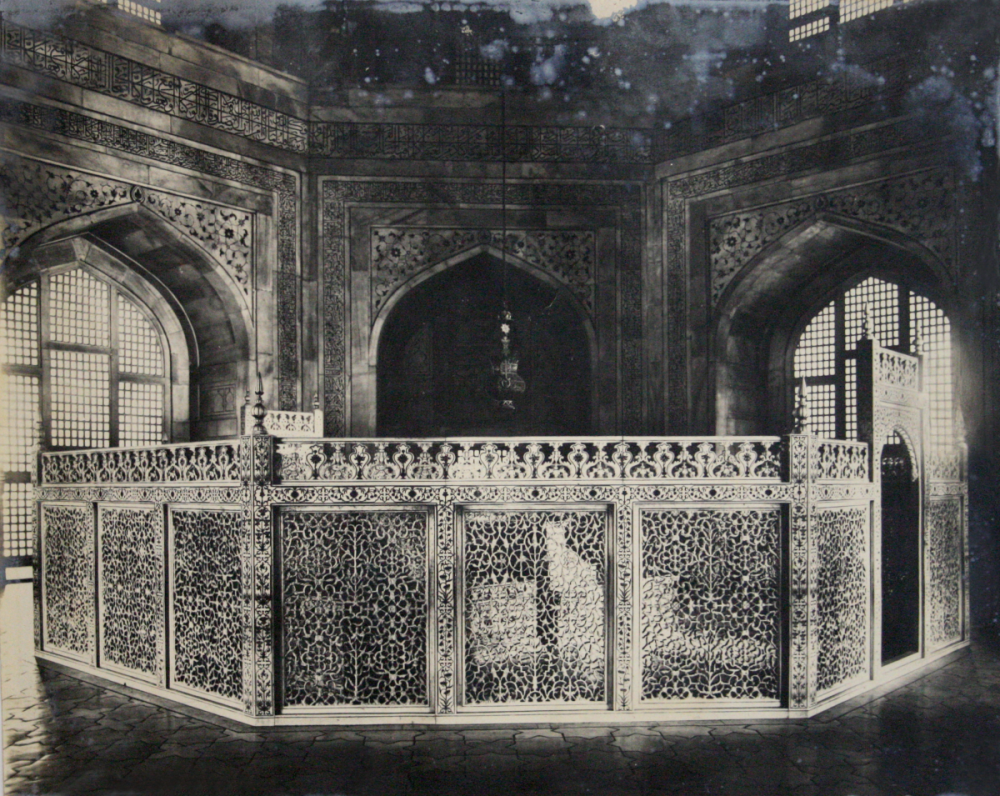
Fig. 11: Tomb chamber and inlaid marble screen surrounding the cenotaphs
The Mahtab Bagh is placed directly opposite the Taj Mahal on the river’s north bank (Fig. 12)
Fig. 12: The Mahtab Bagh as viewed from the Taj Mahal
The garden with its large reflecting pool was known from Mughal times, but silting caused by continuous flooding covered the pool and it was essentially forgotten. Instead a fictitious account of a second Taj Mahal, this one to have been built in black stone, that was first mentioned by a late 17th century European merchant, spread like wildfire and was perpetuated over time. Excavations by the Archaeological Survey of India in the 1990s unearthed the original Mughal garden squashing the myth of the black Taj.
The tomb complex was commenced six months after the queen’s death and by June 1632, the first anniversary of her death, known as ‘urs, that is, the marriage of her soul with God, was commemorated in solemn ceremonies involving prayer and the distribution of largess to the needy. Court historians used the occasion of the annual ‘urs to indicate progress towards the complex’s completion. Europeans too wrote about the stages of construction, although it appears their observations were made from a distance, not the result of having examined the site first-hand.
Today the Taj Mahal complex is a world heritage tourist site. Anyone who can afford the entrance fee can visit the site. However this was not the case during Mughal times. Only those close to the royal family had access to the tomb garden. While many may have arrived on roads, Shah Jahan preferred to visit the tomb on a boat and would enter the complex via water gates, now closed, on the great plinth. Few Europeans prior to the 18th century set foot in the complex. An exception was Francois Bernier, a French physician who had access to the royal family later in the 17th century, who was allowed to enter the Taj’s grounds, although he was denied access to the tomb itself on the grounds that he was not a Muslim.
When Shah Jahan died in 1666 after being imprisoned by his son and successor, Aurangzeb, for eight years, he was buried in the Taj Mahal next to his wife. The question is: was this always his intention? Texts are silent on this issue, but one of the Taj Mahal’s official names, Rauza-i-Munavvara, ‘the Illumined Tomb’, an epithet shared with the Prophet Muhammad’s tomb in Medina, suggests that Shah Jahan always intended the Taj Mahal to be his tomb as well. He wished history to remember him, like the Prophet Muhammad, to conform to the Islamic theological concept of a Perfect Man. It would seem unlikely that the queen’s tomb would have been given the same name as the Prophet’s tomb, since he was a man, unless Shah Jahan saw it as his final resting place as well.
No aspect of this complex was left to chance. Every measurement was carefully recorded in historical chronicles, and clearly the tomb and garden complex were designed by someone with an extraordinary vision. We know from contemporary texts the names of a number of architects who were engaged in the construction of Shah Jahan’s numerous building projects, many of them built concurrently with the Taj Mahal, but these same chronicles are silent on the architect of the Taj Mahal. Only the calligrapher, Amanat Khan, is named. Clearly architects and engineers worked on the massive complex, but by leaving these players anonymous, it is the patron, Shah Jahan, whose role is highlighted.
